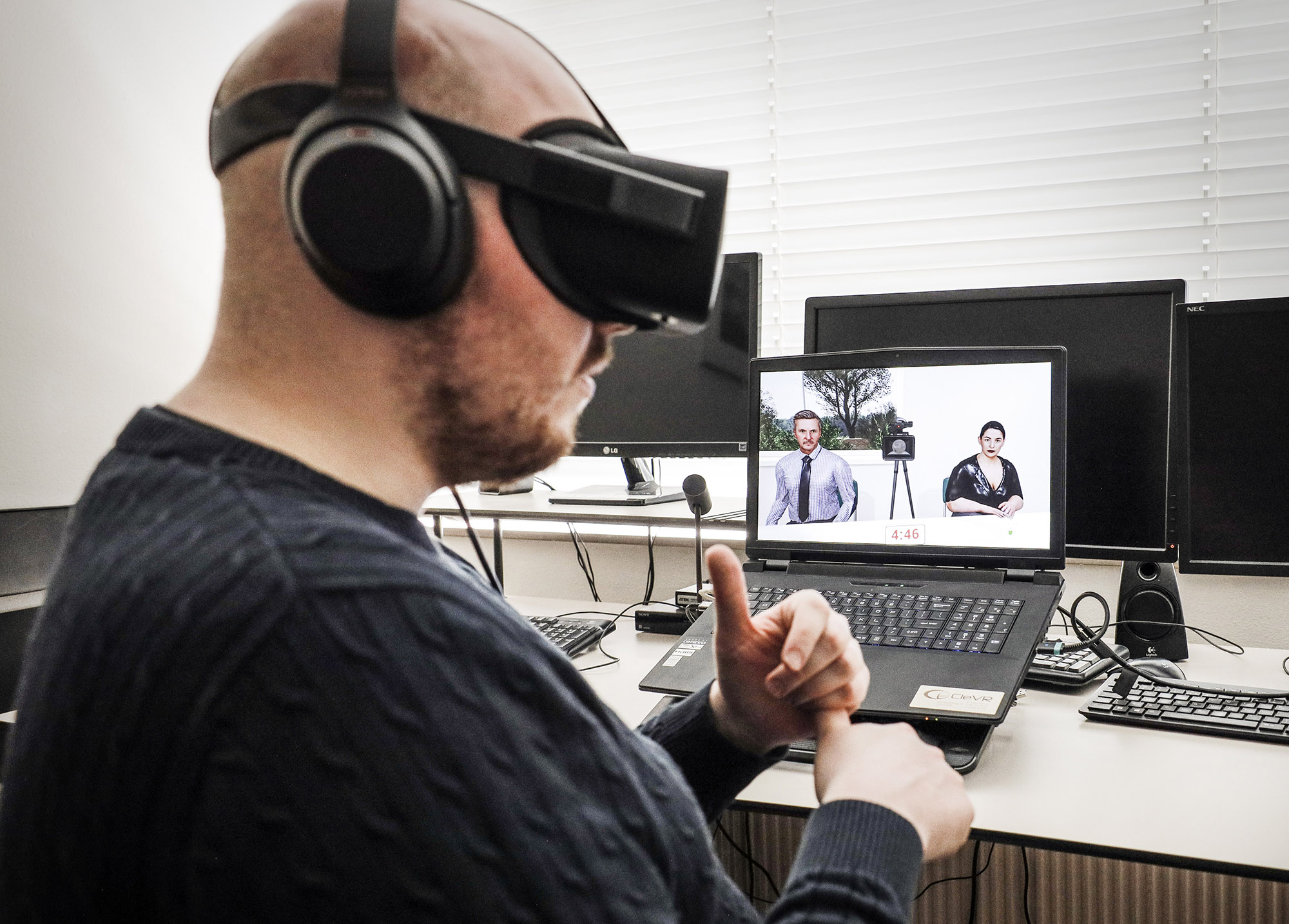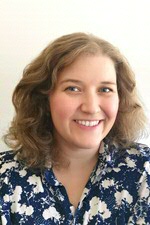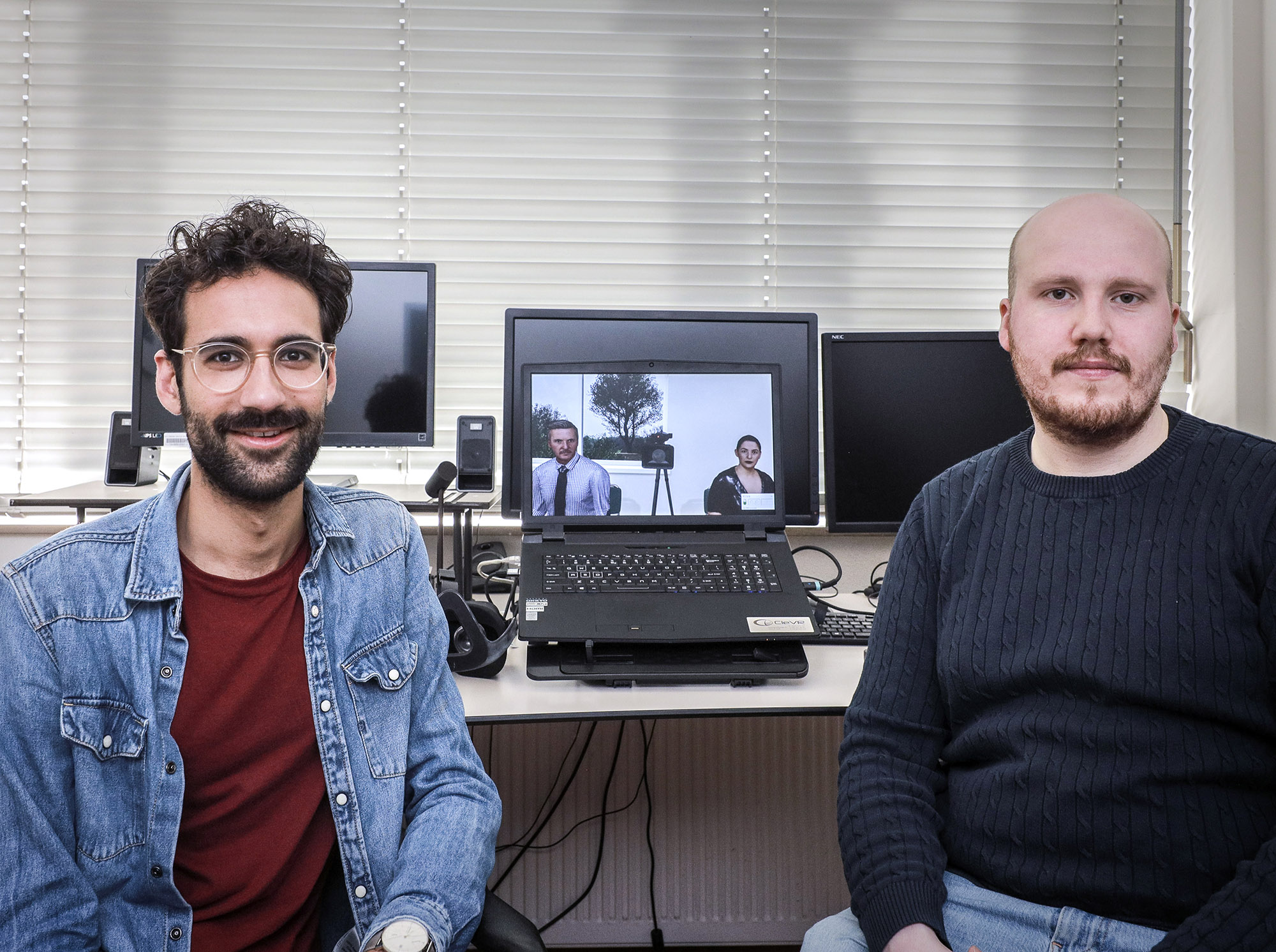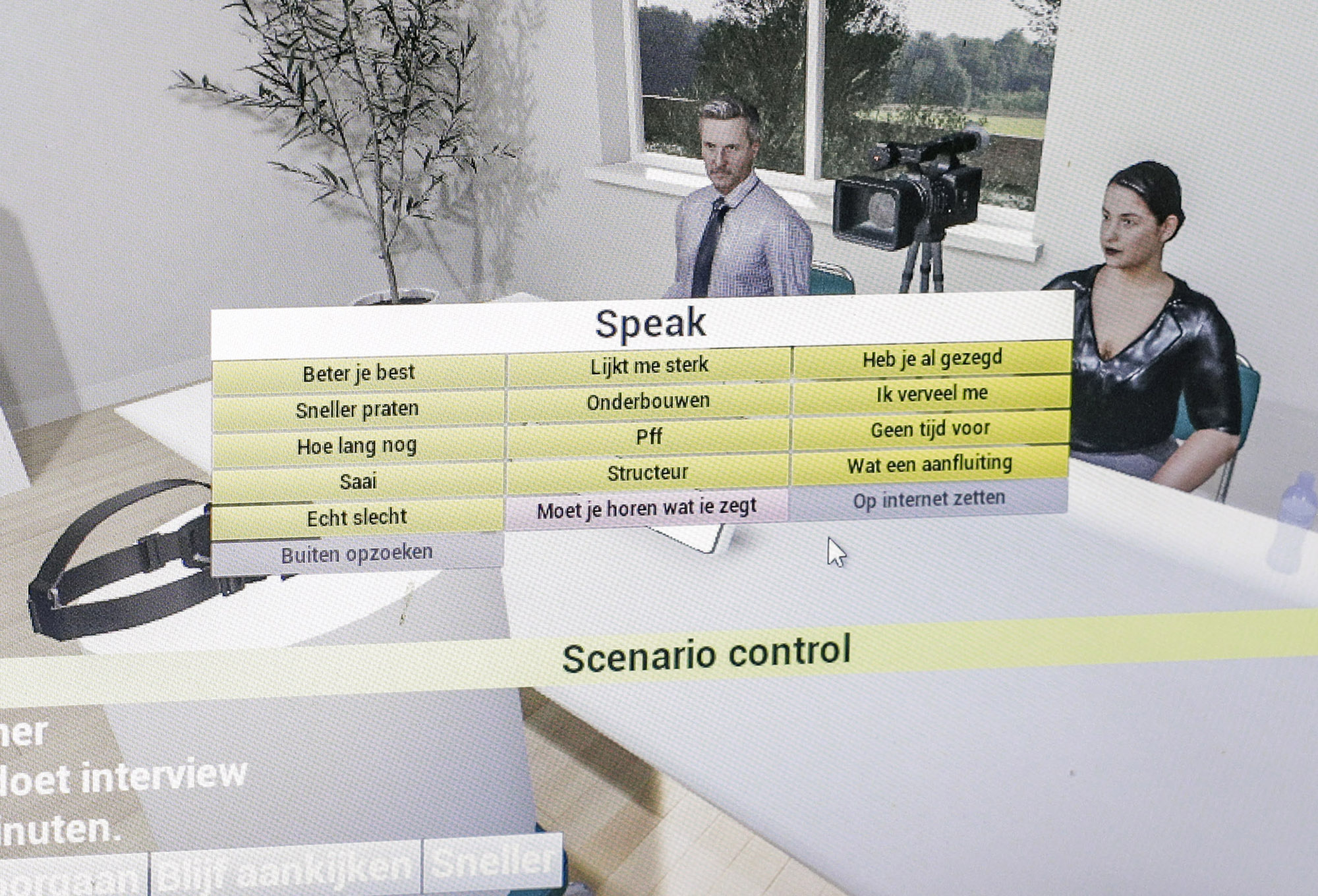Virtual job interview maps stress

We all suffer from it from time to time: stress... It is a major factor in people's mental and physical health. The Psychiatry Department at the UMCG is conducting research on stress resilience, using virtual reality to properly map the impact of stress. This way you can create a stressful situation in a controlled manner. For this purpose, the visualization team at the Centre for Information Technology developed an environment in the form of a virtual job interview.
Text: Kristien Piersma, photography: Henk Veenstra

Catheleine van Driel is a doctor in training to become a psychiatrist at the University Medical Centre (UMCG) and is researching the development of techniques that can help people learn to cope with stress. By making use of virtual reality (VR) it is possible to simulate very realistic situations, making it possible to measure how a person deals with a stressful situation.
Building Bounce Back
PhD researcher Mathijs Nijland and research associate Bart Lestestuiver are closely involved in carrying out the stress resilience study called 'Building Bounce Back'. Nijland: 'Physically, stress is associated with all kinds of symptoms such as cardiovascular disease. We see that people improve psychologically and physically when stress is reduced. So, stress resilience is important in many situations.' The research using the virtual stress test aims to induce stress in a controlled way. Ultimately, the aim is to teach people techniques on how to deal with that stress.
Trier Social Stress Test
A well-known test in psychology to induce stress is the Trier Social Stress Test (TSST). A test subject first sits in a waiting room for a while and then has an interview with an interview panel. This is followed by a math test. 'The subject is being assessed and has to do well, which causes a lot of stress', Nijland explains. Throughout the test, continuous measurements are taken. 'The disadvantage of the test is that for the application panel, you need a room for two people who always have to respond in exactly the same way. That is why we came up with the idea of building the stress test in virtual reality.' The aim is to see if the virtual stress test manages to elicit an equally good stress response compared to the real stress test.

Re-use of software
Stress resilience research was one of the awarded projects in the UG's Centre for Information Technology (CIT) 2021 call for proposals. With this, the researchers received 400 hours of support from the CIT. Together with Pyotr Svetachov from the CIT visualization team, the virtual job interview scenario was first discussed. Svetachov: 'As it happens, we had already been working on another application, the virtual preschool. With it, students in elementary teacher education can practise keeping order in the group while a guardian can control the children via a PC. We could re-use this application and convert it into a virtual application panel that conducts an interview with a test subject. A supervisor can decide via computer which questions to ask and how to respond to the subject's story.' The software of the virtual preschool class itself is again from the University of Würzburg. There, it was used to manage a class of secondary school students. 'By using existing software, many functionalities no longer need to be developed, which would take a lot of extra hours. That is why we try to re-use software as often as possible.'
VR-world
In close consultation with team Visualization, the scenarios of the virtual job interview were determined and written out. Svetachov: 'To make the avatars, the characters in the virtual test, as realistic as possible, they have facial animations, and when the avatar talks, the lips also move at the right moment. Everything has to be synchronised, like the movement of the arms and head.' In the first version, researchers can indicate whether panellists should act bored or be attentive. There are a few types of behaviours attached to that. When behaving bored, the panelists check their smartphones, and when behaving attentively, they will sit all the way to the front of the chair.' Bart Campman of the visualization team developed the 3D models, animations, and the virtual interview room. By using code, Svetachov ensured that all animations start at the right time and respond to what the researcher wants.
Uncanny valley effect
Even though the avatars are not actual people, it does have an effect on the test subjects. Lestestuiver: 'Because it is 360 degrees, the test subject is completely immersed in the VR world. The avatars, again, should not be too real because then it becomes creepy. This will result in the so-called uncanny valley effect.'

Inducing stress
Meanwhile, the first virtual job interviews have 'taken place' to see if the test is actually stressful. Prior to the test, the subjects first complete a questionnaire on general characteristics. At that point, they do not know what will happen, only that they are participating in a study with VR. Lestestuiver: There has to be an element of surprise to induce the stress.”
Applying!
Once the VR glasses are put on, the test subject is first in a virtual waiting room. After approximately 20 minutes, the announcement follows that a job interview will take place. After five minutes of preparation time during which tension is already building, the test subject enters the virtual interview room with the interview panel for the job interview. The researcher has a number of options to respond with the different versions programmed. Finally, the math test follows.
The stress is measured in two different ways. Nijland: 'Before and after each part, the participants complete a questionnaire. During completion, salivary cortisol levels are measured by chewing on a cotton ball. This tells us how much stress hormone a person has at that moment. Also, the heart rate is measured continuously.'
Upgrade with a control variant
The pilot has since been completed and initial results look good. Nijland: 'The measurements show an increase in stress before and after the test. This is something we can continue to work with.' Recently, Svetachov has been upgrading by adding a control variant in the form of a friendly version. 'With the upgrade, we can do a randomized study with a control group,' Nijland explains. 'Ultimately, we want to compare the data we collect with the data already known from the literature. This would allow us to show that this VR stress test is actually as effective or maybe even more effective than the real variant. If it turns out to be a stress test that works well, you can teach someone stress-reducing techniques such as breathing exercises beforehand in the future. This could be applicable in different situations, such as in the treatment of psychiatric patients, but also in employee burnout recovery.'
Further information
-
On September 22, the XR-HUB meeting takes place in the Smitsborg where this topic is also discussed. Check the website for more information.
-
Those interested in learning more about visualisation in educational applications or visiting the VR lab may contact CIT's visualization team.
-
An overview of all stress resilience projects can be found on the Bounce Back Lab website.
More news
-
17 November 2025
Artificial intelligence in healthcare
-
04 November 2025
AI Factory in Groningen advances digital sovereignty
-
03 November 2025
Menopause in perspective: How the media influences our perception
